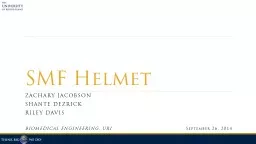

Zachary Jacobson Shante Dezrick Riley Davis Biomedical Engineering URI September 26 2014 Structure of presentation Design Process Clinical Studies Future work Design Process ID: 228948
Download Presentation The PPT/PDF document "SMF Helmet" is the property of its rightful owner. Permission is granted to download and print the materials on this web site for personal, non-commercial use only, and to display it on your personal computer provided you do not modify the materials and that you retain all copyright notices contained in the materials. By downloading content from our website, you accept the terms of this agreement.
Slide1
SMF Helmet
Zachary
Jacobson
Shante
Dezrick
Riley
Davis
Biomedical
Engineering
,
URI
September 26, 2014Slide2
Structure of presentation
Design Process
Clinical Studies
Future workSlide3
Design Process
GoalsSlide4
Design Process
Concept
Static Magnets
Rare-earth magnets
Able to reverse polarity
Manual
Wires/motor
Mechanism
Placement must be flexible to meet patient needs
4 target lobes of the brain
Magnets fixed into podsSlide5
Figure
1
Target
lobes of the brain. The front of the head is towards the left, the back is towards the rightSlide6
Design
1
Mechanical flip, independent magnet podSlide7
Design 2
Wire-rotated magnets, linear movement flexibility
Figure 2
Mechanism of action for Design
2Slide8
SolidWorks
3D PrintingSlide9
SolidWorks
3D PrintingSlide10
URI Clinical Studies
& Future WorkSlide11
URI Clinical studies
Goals
IRB
approval pending
15-30 person blind study
Two 1-hour sessions per person
One full half-brain stimulation
One sham
Looking for effect on
short-term
memory, hand-eye coordination, speed Will be tested through a randomized, timed, dot-connecting gameEvaluated based on timing and accuracySlide12
Figure
3
GUI for dot-connecting game to be used in clinical trial. It includes 4 sets of figures shown over 4 seconds. The user than has 17 seconds to correctly reproduce the 4 figures in order.
Designed in such a way that users will not get better scores through repetition of the game. This insures that the measured differences in accuracy and timing can be attributed to the SMF Helmet.Slide13
References
Y
.
Levkovitz
, E. V
Harel
, Y. Roth, Y.
Braw, D. Most, L. N. Katz, A. Sheer, R. Gersner, and A. Zangen, “Deep transcranial magnetic stimulation over the prefrontal cortex: evaluation of antidepressant and cognitive effects in depressive patients.,” Brain Stimul., vol. 2, no. 4, pp. 188–200, Oct. 2009.L. Anderkova and I. Rektorova, “Cognitive effects of repetitive transcranial magnetic stimulation in patients with neurodegenerative diseases - clinician’s perspective.,” J. Neurol. Sci., vol. 339, no. 1–2, pp. 15–25, Apr. 2014.J.-P. Lefaucheur, “Treatment of Parkinson’s disease by cortical stimulation.,” Expert Rev. Neurother., vol. 9, no. 12, pp. 1755–71, Dec. 2009.M. Cotelli, R. Manenti, S. F. Cappa
, O.
Zanetti
, and C. Miniussi, “Transcranial magnetic stimulation improves naming in Alzheimer disease patients at different stages of cognitive decline.,” Eur. J. Neurol., vol. 15, no. 12, pp. 1286–92, Dec. 2008.“NeuroStar TMS Therapy Depression Treatment.” [Online]. Available: http://neurostar.com/. [Accessed: 10-Sep-2014].A. P. Colbert, H. Wahbeh, N. Harling, E. Connelly, H. C. Schiffke, C. Forsten, W. L. Gregory, M. S. Markov, J. J. Souder, P. Elmer, and V. King, “Static magnetic field therapy: a critical review of treatment parameters.,” Evid. Based. Complement. Alternat. Med., vol. 6, no. 2, pp. 133–9, Jun. 2009.J. M. D. Coey, “Rare-earth magnets,” Endeavour, vol. 19, no. 4, pp. 146–151, Jan. 1995.A
. T. Sack, R. Cohen Kadosh, T.
Schuhmann, M. Moerel, V. Walsh, and R. Goebel, “Optimizing functional accuracy of TMS in cognitive studies: a comparison of methods.,” J.
Cogn
.
Neurosci
., vol. 21, no. 2, pp. 207–21, Feb. 2009.
A
. Aleman and M.
van’t
Wout
, “Repetitive transcranial magnetic stimulation over the right dorsolateral prefrontal cortex disrupts digit span task performance.,”
Neuropsychobiology
, vol. 57, no. 1–2, pp. 44–8, Jan. 2008.
Y
.
Levkovitz
, Y. Roth, E. V.
Harel
, Y.
Braw
, A. Sheer, and A.
Zangen
, “A randomized controlled feasibility and safety study of deep transcranial magnetic stimulation.,”
Clin
.
Neurophysiol
., vol. 118, no. 12, pp. 2730–44, Dec. 2007.